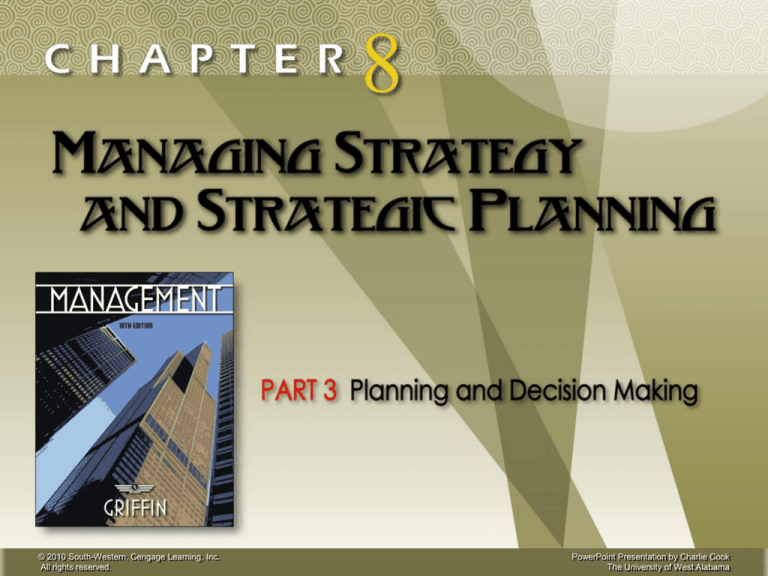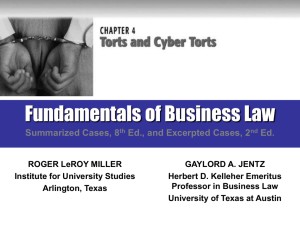
© 2010 South-Western, Cengage Learning, Inc.
All rights reserved.
PowerPoint Presentation by Charlie Cook
The University of West Alabama
The Nature of Strategic Management
• Strategy
Is a comprehensive plan for accomplishing an
organization’s goals.
• Strategic Management
Involves formulating and implementing strategies to
take advantage of business opportunities and meet
competitive challenges.
• Effective Strategies
Promote superior alignment between an organization,
its environment, and its goals.
© 2010 South-Western, Cengage Learning, Inc. All rights reserved.
8–2
Components of Strategy
Components of Strategy
Distinctive
Competence
Competitive
Scope
© 2010 South-Western, Cengage Learning, Inc. All rights reserved.
Resource
Deployment
8–3
Strategic Alternatives
Corporate-level strategy
Market A
Market B
Business-level strategy
Business-level strategy
Functional-level strategy
Functional-level strategy
Operations-level strategy
Operations-level strategy
© 2010 South-Western, Cengage Learning, Inc. All rights reserved.
8–4
Types of Strategic Alternatives
• Business-Level Strategy
The set of strategic alternatives that an organization
chooses from as it conducts business in a particular
industry or a particular market.
• Corporate-Level Strategy
The set of strategic alternatives that an organization
chooses from as it manages its operations
simultaneously across several industries and several
markets.
© 2010 South-Western, Cengage Learning, Inc. All rights reserved.
8–5
Strategy Formulation and Implementation
• Strategy Formulation
The set of processes involved in creating or
determining the organization’s strategies; it focuses
on the content of strategies.
• Strategy Implementation
The methods by which strategies are operationalized
or executed within the organization; it focuses on the
processes through which strategies are achieved.
© 2010 South-Western, Cengage Learning, Inc. All rights reserved.
8–6
Management Challenge
• If it is important that all employees be involved
in strategy implementation, then what are the
most important responsibilities for managers in
helping them participate?
© 2010 South-Western, Cengage Learning, Inc. All rights reserved.
8–7
Types of Strategies
• Deliberate Strategy
A plan, chosen and implemented to support specific
goals, that is the result of a rational, systematic, and
planned process of strategy formulation and
implementation.
• Emergent Strategy
A pattern of action that develops over time in the
absence of goals or missions, or despite goals and
missions.
© 2010 South-Western, Cengage Learning, Inc. All rights reserved.
8–8
8.1
SWOT Analysis
© 2010 South-Western, Cengage Learning, Inc. All rights reserved.
8–9
SWOT Analysis and Strategy
• Evaluating Organizational Strengths
Organizational strengths
are skills and abilities enabling an organization to conceive of
and implement strategies.
Common organizational strengths
are organizational capabilities possessed by numerous
competing firms.
Distinctive competencies
are useful for competitive advantage and superior
performance.
Imitation of distinctive competencies
removes the competitive advantage of the competency.
© 2010 South-Western, Cengage Learning, Inc. All rights reserved.
8–10
SWOT Analysis and Strategy (cont’d)
• Evaluating Organizational Strengths (cont’d)
Sustained competitive advantage
occurs when a distinctive competence cannot be easily
duplicated.
is what remains after all attempts at strategic imitations
cease.
Strategic imitation of a distinctive competence is
difficult when:
it is based on unique historical circumstances.
it is difficult for competitors to understand its nature or
character.
it is based on a complex phenomenon (e.g., organizational
culture).
© 2010 South-Western, Cengage Learning, Inc. All rights reserved.
8–11
SWOT Analysis and Strategy (cont’d)
• Evaluating Organizational Weaknesses
Organizational weaknesses
Skills and capabilities that do not enable an organization to
choose and implement strategies that support its mission.
Weaknesses can be overcome by:
investments to obtain the strengths needed.
modification of the organization’s mission so it can be
accomplished with the current workforce.
Competitive disadvantage
occurs when an organization fails to implement strategies
being implemented by competitors.
© 2010 South-Western, Cengage Learning, Inc. All rights reserved.
8–12
SWOT Analysis and Strategy (cont’d)
• Evaluating an Organization’s Opportunities and
Threats
Organizational opportunities
are areas in the organization’s environment that may
generate high performance.
Organizational threats
are areas in the organization’s environment that make it
difficult for the organization to achieve high performance.
© 2010 South-Western, Cengage Learning, Inc. All rights reserved.
8–13
Formulating Business-Level Strategies
Porter’s Generic
Strategies
Differentiation
strategy
Overall cost
leadership
strategy
© 2010 South-Western, Cengage Learning, Inc. All rights reserved.
Focus
strategy
8–14
Formulating Business-Level Strategies
• Porter’s Generic Strategies
Differentiation strategy
An organization seeks to distinguish itself from competitors
through the quality of its products or services.
Overall cost leadership strategy
An organization attempts to gain competitive advantage by
reducing its costs below the costs of competing firms.
Focus strategy
An organization concentrates on a specific regional market,
product line, or group of buyers.
© 2010 South-Western, Cengage Learning, Inc. All rights reserved.
8–15
8.1
Porter’s Generic Strategies
Strategy Type
Definition
Examples
Differentiation
Distinguish products
or services
Rolex (watches)
Godiva (chocolate)
Mercedes-Benz (automobiles)
Nikon (cameras)
Cross (writing instruments
Overall cost
leadership
Reduce manufacturing
and other costs
Timex (watches)
Hershey (chocolate)
Hyundai (automobiles)
Kodak (cameras)
BIC (writing instruments)
Focus
Concentrate on specific
regional market, product
market, or group of buyers
Tag Heuer (watches)
Vosges (chocolate)
Fiat, Alfa Romeo (automobiles)
Polaroid (cameras)
Waterman (writing instruments)
Fisher-Price (handheld calculators)
© 2010 South-Western, Cengage Learning, Inc. All rights reserved.
8–16
Implementing Porter’s Generic Strategies
• Differentiation
Marketing and sales emphasize high-quality, high-value image
of the organization’s products or services.
• Overall Cost Leadership
Marketing and sales focus on simple product attributes and how
these product attributes meet customer needs in a low-cost and
effective manner.
• Focus
Either differentiation or cost leadership, depending on which one
is the proper basis for competing in or for a specific market
segment, product category, or group buyers.
© 2010 South-Western, Cengage Learning, Inc. All rights reserved.
8–17
Miles and Snow’s Strategy Types
Strategic Types of Organizations
Prospectors
Defenders
© 2010 South-Western, Cengage Learning, Inc. All rights reserved.
Analyzers
Reactors
8–18
Miles and Snow’s Strategy Types
• Prospector
Encourages creativity to seek out new market opportunities and
to take risks.
Develops the flexibility to meet changing market conditions by
decentralizing its organizational structure.
• Defender
Focuses on defending its current markets by lowering its costs
and/or improving the performance of its current products.
• Analyzer
Incorporates elements of both the prospector and the defender
strategies to maintain business and to be somewhat innovative.
• Reactor
Has no clear strategy, reacts to changes and events.
© 2010 South-Western, Cengage Learning, Inc. All rights reserved.
8–19
8.2
The Miles and Snow Typology
Strategy Type
Definition
Examples
Prospector
Is innovative and growth oriented,
searches for new markets and new growth
opportunities, encourages risk taking
Amazon.com
3M
Rubbermaid
Defender
Protects current markets, maintains stable
growth, serves current customers
BIC
eBay
Mrs. Fields
Analyzer
Maintains current markets and current
customer satisfaction with moderate
emphasis on innovation
DuPont
IBM
Yahoo!
Reactor
No clear strategy, reacts to changes in the
environment, drifts with events
International Harvester
(now doing business as Navistar)
Joseph Schlitz Brewing Co.
Kmart
Montgomery Ward
(no longer in business)
© 2010 South-Western, Cengage Learning, Inc. All rights reserved.
8–20
8.2
The Product Life Cycle
High
Stages
Growth
Maturity
Decline
Sales Volume
Introduction
Low
Time
© 2010 South-Western, Cengage Learning, Inc. All rights reserved.
8–21
Management Challenge Questions
• Which of Porter’s generic strategies are best
suited for which stages of the product life cycle?
• Which of the Miles and Snow’s types of effective
strategic organizations are most appropriate for
which stage of the product life cycle?
• Do your answers support the concept that
structure must follow strategy?
© 2010 South-Western, Cengage Learning, Inc. All rights reserved.
8–22
Formulating Corporate-Level Strategies
• Strategic Business Units
Each business or group of businesses within an
organization is engaged in serving the same markets,
customers, or products.
• Diversification
The number of businesses an organization is
engaged in and the extent to which these businesses
are related to one another
© 2010 South-Western, Cengage Learning, Inc. All rights reserved.
8–23
Corporate-Level Strategies
Strategic Choices
Single-product
strategy
(simplicity)
Related
diversification
(synergy)
© 2010 South-Western, Cengage Learning, Inc. All rights reserved.
Unrelated
diversification
(risk/return)
8–24
Corporate-Level Strategies
• Single-Product Strategy
An organization manufactures one product or service
and sells it in a single geographic market.
• Related Diversification
A strategy in which an organization operates in
several different businesses, industries, or markets
that are somehow linked.
Avoids the disadvantages and risks of a single-
product strategy.
© 2010 South-Western, Cengage Learning, Inc. All rights reserved.
8–25
8.3
Bases of Relatedness in Implementing
Related Diversification
Basis of Relatedness
Examples
Similar technology
Philips, Boeing, Westinghouse
Common distribution
and marketing skills
Kraft Foods, Philip Morris, Procter & Gamble
Common brand name
and reputation
Disney, Universal
Common customers
Merck, IBM, AMF-Head
© 2010 South-Western, Cengage Learning, Inc. All rights reserved.
8–26
Advantages of Related Diversification
• Reduces an organization’s dependence on any one of its
business activities and thus reduces economic risk.
• Reduces overhead costs associated with managing any
one business through economies of scale and
economies of scope.
• Allows an organization to exploit its strengths and
capabilities in more than one business.
• Synergy exists among a set of businesses when the
businesses’ value together is greater than their
economic value separately.
© 2010 South-Western, Cengage Learning, Inc. All rights reserved.
8–27
Unrelated Diversification
• Unrelated Diversified Organization
Operates multiple businesses that are not logically
associated with one another.
Advantages
Stable performance over time due to business cycle
differences among the multiple businesses.
Allocation of resources to areas with the highest return
potentials to maximize corporate performance.
Disadvantages
Poor performance due to the complexity of managing a
diversity of businesses.
Failing to exploit key synergies puts the firm at a competitive
disadvantage to firms with related diversification strategies.
© 2010 South-Western, Cengage Learning, Inc. All rights reserved.
8–28
Becoming a Diversified Firm
Diversification Alternatives
Development of
new products
Vertical
integration
© 2010 South-Western, Cengage Learning, Inc. All rights reserved.
Merger with
another firm
Acquisition of
another firm
8–29
Becoming a Diversified Firm
• Replacement of Suppliers And Customers
Backward vertical integration
Beginning a business that furnishes resources previously
handled by a supplier.
Forward vertical integration
Beginning a business previously handled by an intermediary
and selling more directly to customers.
© 2010 South-Western, Cengage Learning, Inc. All rights reserved.
8–30
Becoming a Diversified Firm (cont’d)
• Purposes of Mergers and Acquisitions
To diversify through vertical integration.
To acquire complementary products or services
linked by a common technology and common
customers.
To create or exploit synergies that reduce the
combined organizations’ costs of doing business to
increase revenues.
© 2010 South-Western, Cengage Learning, Inc. All rights reserved.
8–31
Managing Diversification
• Major Tools for Managing Diversification
Organization structure
A detailed discussion of organization structure is contained in
Chapter 12.
Portfolio management techniques
Methods used by diversified firms to make decisions about
what businesses to engage in and how to manage these
businesses to maximize corporate performance.
Two important portfolio management techniques
The BCG Matrix
The GE Business Screen
© 2010 South-Western, Cengage Learning, Inc. All rights reserved.
8–32
Managing Diversification (cont’d)
• BCG Matrix
Evaluates a portfolio of businesses on the growth rate
of their respective markets and each business’s
relative share of its market.
Classifies the types of businesses in a diversified
firm’s portfolio as:
“Dogs” have small market shares and no growth prospects.
“Cash cows” have large shares of mature markets.
“Question marks” have small market shares in quickly
growing markets.
“Stars” have large shares of rapidly growing markets.
© 2010 South-Western, Cengage Learning, Inc. All rights reserved.
8–33
8.3
The BCG Matrix
Market Growth Rate
High
Stars
Question
marks
Cash Cows
Dogs
Low
High
Relative Market Share
© 2010 South-Western, Cengage Learning, Inc. All rights reserved.
Low
8–34
Managing Diversification (cont’d)
• GE Business Screen
A method of evaluating businesses in a diversified
portfolio along two dimensions, each of which
contains multiple factors:
Industry attractiveness.
Competitive position (strength) of each firm in the portfolio.
In general, the more attractive the industry and the
more competitive a business is, the more resources
an organization should invest in that business.
© 2010 South-Western, Cengage Learning, Inc. All rights reserved.
8–35
Industry Attractiveness
8.4
The GE Business Screen
High
Winner
Winner
Question
mark
Medium
Winner
Average
business
Loser
Profit
producer
Loser
Loser
Low
Good
Medium
Poor
Competitive Position
Competitive Position
Industry Attractiveness
1.
2.
3.
4.
5.
6.
1.
2.
3.
4.
Market share
Technological know-how
Product quality
Service network
Price competitiveness
Operation costs
© 2010 South-Western, Cengage Learning, Inc. All rights reserved.
Market growth
Market size
Capital requirements
Competitive intensity
8–36
International and Global Strategies
Developing International
and Global Strategies
Global
efficiencies
Multimarket
flexibility
© 2010 South-Western, Cengage Learning, Inc. All rights reserved.
Worldwide
learning
8–37
International and Global Strategies
• Developing International and Global Strategies
Global efficiencies
Location efficiencies—seeking lower input cost locations
Economies of scale—larger facilities result in lower costs
Economies of scope—broadening product lines
Multimarket flexibility
International businesses may respond to a change in one
country by implementing a change in another country.
Worldwide learning
The diverse operating environments of multinational
corporations (MNCs) contribute to organizational learning
that can be transferred to other operating environments.
© 2010 South-Western, Cengage Learning, Inc. All rights reserved.
8–38
Strategic Alternatives
for International Businesses
Strategic
Alternatives
Home replication
Multi-domestic strategy
Global strategy
Transnational strategy
© 2010 South-Western, Cengage Learning, Inc. All rights reserved.
8–39
Strategic Alternatives
for International Businesses
• Home Replication
Utilizing a core competency or a firm-specific
advantage developed at home as a main competitive
weapon in foreign markets.
• Multi-Domestic Strategy
Managing a corporation as a collection of
independent operating subsidiaries frees a firm to
customize its products, its marketing campaigns, and
operating techniques to meet local customer needs.
© 2010 South-Western, Cengage Learning, Inc. All rights reserved.
8–40
Strategic Alternatives
for International Businesses (cont’d)
• Global Strategy
Viewing the world as a single marketplace and having
as a primary goal the creation of standardized goods
and services that will address the needs of customers
worldwide.
• Transnational Strategy
Attempting to combine the benefits of scale
efficiencies pursued by a global corporation, with the
benefits and advantages of local responsiveness of a
multi-domestic corporation.
© 2010 South-Western, Cengage Learning, Inc. All rights reserved.
8–41






